David Linkie looks back on a year of contrasts from a personal perspective
Yet again, the support of many in the UK fishing industry has enabled a succession of achievements to be covered in Fishing News over the past 12 months.
Continuing high levels of investment in new vessels, and in the equally important shore-based infrastructure, led to a wide range of positive news stories and features that provided encouraging signs of progression by a diverse industry that, while forward-looking on many fronts, does not always receive the credit it deserves from the wider media, and therefore from the general public.
The opportunity to highlight major accomplishments and developments on a regular basis is of paramount importance – not least because it is a reminder of what can be made possible by working together, in an industry in which the total strength, and ability to overcome adversity by deploying divergent thinking, is much higher than the sum of its component parts.
The high level of reinvestment in new vessels by strongly motivated owners that prevailed in 2018 continued through 2019. At times, this led to practical challenges in terms of being in the right place at the right time. When such logistical difficulties did occur, these were, as always, readily resolved with the willing support of skippers, boatyard/harbour staff and friends. Sincere thanks to everyone who provided assistance in various forms.
January
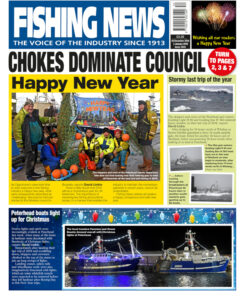 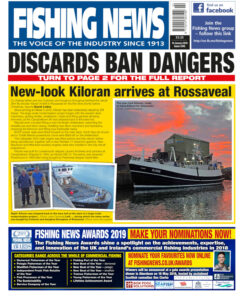 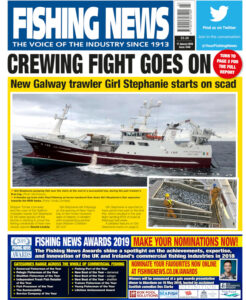  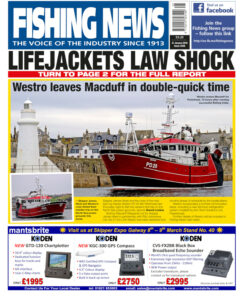 |
Following a year in which the main ports in England and Scotland posted new annual catch value records, and some segments of the fleet experienced one of their most successful years in recent memory, 2019 was always going to be a different kettle of fish, not least because of quota cuts for some of the main species coinciding with the full implementation of landing obligation requirements.

Shooting away the twin-rig prawn trawls for the first time as Westro ran fishing trials from Macduff.
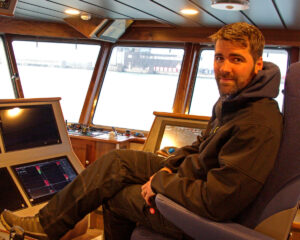
Co Galway skipper Tomás Conneely’s…
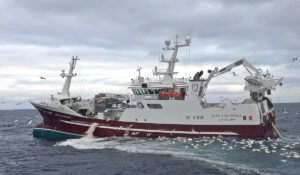
… midwater trawler Girl Stephanie was the first new boat to be featured in Fishing News in 2019.
It was therefore no surprise that the discards ban featured prominently in early news headlines, alongside the continuing saga of Brexit. Crewing issues were another underlying problem that quickly resurfaced, but – as with the other two recurring themes – without any tangible resolution, despite unrelenting efforts by many in the industry.
The Co Donegal and Co Kerry vessels Girl Stephanie and Fiona K III were the first new boats to be featured in Fishing News.
Peterhead skipper James West’s new 21.5m twin-rig trawler Westro ran fishing trials towards the end of the month, after being completed nearly two months ahead of schedule by Macduff Shipyards.
Arriving at Macduff 18 hours before Westro was scheduled to leave harbour on the tide at 7am the following morning, prospects for trials going ahead as planned didn’t look too hopeful, with the tail end of a northerly gale sending spray over the trawler, which was lying at the back of the fishmarket. Fortunately, the forecast for the wind to come round to the south overnight was accurate, allowing the trials to go ahead – although as conditions were still unsuitable for photographs to be taken as usual from the Macduff pilot boat, these had to be taken the following week.
February
 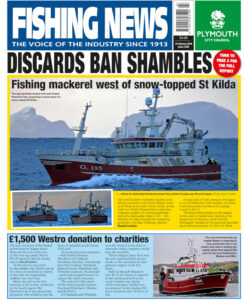 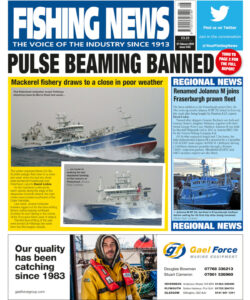 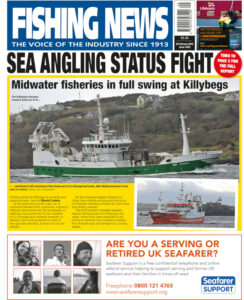 |
Industry fears about the discards ban were strengthened by the report of an influential Lords committee, which took written and oral evidence from a wide range of sources including fisheries minister George Eustice, DEFRA and MMO officials, fishermen, industry leaders, Seafish, port representatives and environmental groups.
The committee said that the requirement to land all catches ‘poses significant challenges to the fishing industry and to enforcement bodies’, including the high risk of early tie-ups, within a few weeks in some areas, because of choke species. This would force fishermen to choose between not fishing for the rest of the year, or breaking the law by continuing to fish for other species and discarding anything caught over quota.
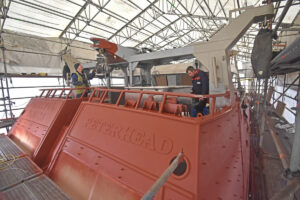
Fruitful Bough was one of four new boats at various stages of construction in Parkol’s yards at Whitby and Teesside.

Delegates at an international conference held in London discussed options for a sustainable future for the scallop sector.
Seafish suggested that £165m-worth of fish could remain uncaught in 2019 due to fishermen having to stop fishing early.
Committee member Lord Krebs said: “Action could have been taken years ago to change how fishing quota is managed and distributed, to improve take-up of technology that can help fishers be more selective in what they catch, and to reach agreement with other member states about the use of cameras to monitor compliance.
“We were shocked to hear – and this was acknowledged by the fisheries minister George Eustice – that some fishermen would have to stop fishing halfway through the year. Industry representatives said it could be as early as this month.
“It’s not a happy position for the industry to be facing a situation where they have to choose between possibly going out of business or breaking the law.”
A high-profile two-day international conference to explore options in the search for a sustainable future for the scallop sector was held in Fishmongers’ Hall in London towards the end of the month, at the same time as the EU announced a ban on pulse beaming from July 2021.
As is frequently the case when travelling for one specific reason, going to Bridlington to meet skipper James Haxby and the crew of the new Filey-owned catamaran potter Pilot Me also generated opportunities to obtain news stories on the next four new Parkol builds that were in various stages of construction at their Whitby and Middlesbrough yards.
March
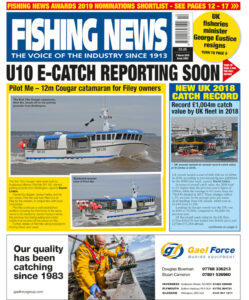 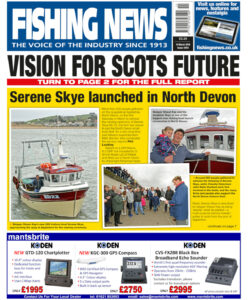 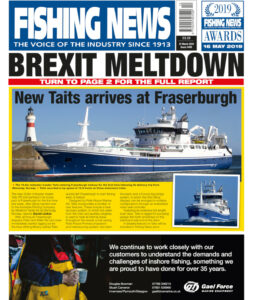 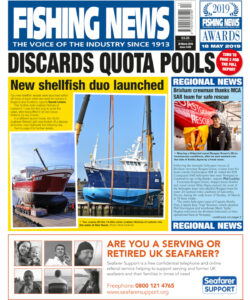 |
The successful performance that UK vessels returned in 2018 was confirmed by provisional MMO figures that showed that the annual catch value exceeded £1bn for the first time. Shellfish contributed £338m, demersal £349m and pelagic £296m to the total catch value for the UK fleet in 2018.
UK fisheries minister George Eustice unexpectedly resigned from the government over prime minister Theresa May’s promise to allow MPs a vote on delaying Brexit, if her latest deal was rejected.
A wide range of fishermen from all parts of the UK were included when the nomination shortlists for the Fishing News Awards 2019 were announced.
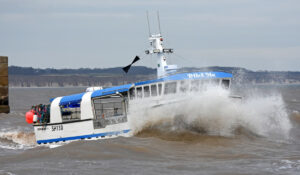
Pilot Me follows a pirate ship out of Bridlington harbour.
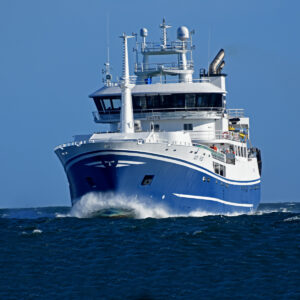
The new pelagic vessel Taits approaching Fraserburgh for the first time.
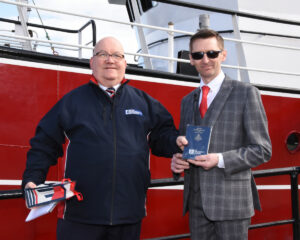
Peterhead Fishermen’s Mission superintendent Steve Murray presents a copy of the New Testament to skipper James West during the naming ceremony of the new twin-rig trawler Westro.
The diversity of new vessels entering service was highlighted when five boats, ranging in size from 8m to 75m, for owners in Devon, North East Scotland and Yorkshire, were featured on the front covers of four successive issues of Fishing News.
That some of the accompanying images were taken as a result of effectively press-ganging a pirate ship at Bridlington, and the crew of a creel boat about to head home on a morning when conditions were unsuitable for hauling their gear off Fraserburgh, underlined the saying ‘shy bairns get nowt’, and the positive responses frequently received.
Well-established safety drills, including the mandatory wearing of PFDs when on deck, contributed to crewman Reegan Green being safely winched from the sea by an HM Coastguard SAR helicopter after going over the side of the Brixham beamer Emilia Jayne, 25 miles southeast of Salcombe in 70-knot winds.
The Longhope lifeboat tragedy, which claimed the lives of eight crew members in horrendous weather, after launching to assist a disabled Libyan vessel in the Pentland Firth on 17 March, 1969, was marked by a 50th anniversary commemoration in Orkney. For someone who remembers local people throwing coins into the lifeboat as it passed through Berwick on a lorry, it is difficult to believe that 50 years have passed since that poignant memory was formed.
April
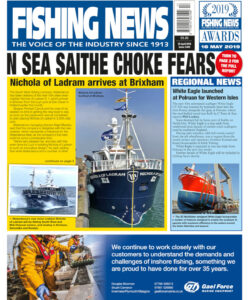 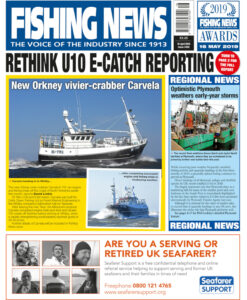 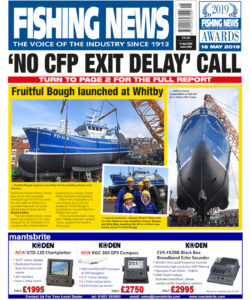 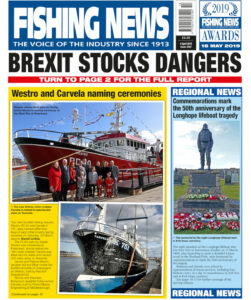 |
That the naming ceremonies for two new Scottish shellfish vessels, Westro and Carvela – held within an hour of each other at Peterhead and Middlesbrough – clashed was unfortunate, but unavoidable.
A few days later, another new Peterhead twin-rig trawler, skipper Robert West’s Fruitful Bough, was lifted into the water at Whitby. Twenty-four hours later, the Stromness vivier-crabber Carvela was scheduled to arrive at Whitby from Teesside, thereby ensuring maximum benefit from an overnight stay in Whitby.
Although sea conditions were forecast to deteriorate fairly quickly after Carvela was due to pass between the Whitby pier ends, the initial weather window looked favourable. This was certainly the case when lying near the Bell Buoy, waiting for the vivier-crabber to arrive, when fortunate timing gave opportunities to photograph the recently renamed scallopers Frida Lee and Autumn J, which subsequently came in handy for Boat of the Week.
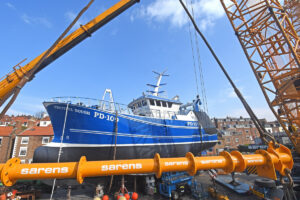
Rigging up to lift Fruitful Bough into the river Esk at Whitby.
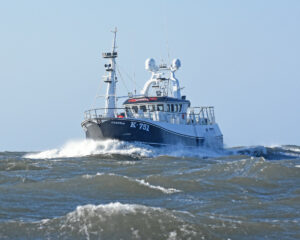
The Orkney vivier-crabber Carvela approaching Whitby from Teesside in rapidly freshening weather.
Shortly after Autumn J passed, the wind freshened up earlier than expected to 25-30 knots, with Carvela still a couple of miles to seaward of a 22ft boat. While photographs were successfully taken with the help of skipper Ronnie Norquoy, they came at the cost of a cold and wet drive back home, not having thought that oilskins or boots, left on the quayside, would be required.
After the shellfish boats Nicola of Ladram, Amberlisa and Eternal Light were launched at Den Oever, Arklow and Buckie respectively, a busy month ended with HRH The Princess Royal naming UK Fisheries’ 81m factory freezer trawler Kirkella on the river Thames at Greenwich.
The invitation to join Kirkella at Tilbury, before proceeding upriver to pass through Tower Bridge and complete a 360 in the Pool of London before heading downstream to pick up pontoon moorings near the Cutty Sark, was a déjà vu moment, as it recalled happy memories from a similar experience on the Peterhead pelagic vessel Lunar Bow, which berthed alongside HMS Belfast in 2011.
The following morning, in a supremely well-organised event, some 300 invited guests were transferred to a marquee erected on a pontoon under the towering starboard bow of Kirkella, against which HRH The Princess Royal broke the customary bottle of champagne. When the guests returned ashore to Greenwich, they were treated to traditional fish and chips in Cutty Sark Gardens, together with well over 1,000 members of the public, courtesy of UK Fisheries Ltd.
May
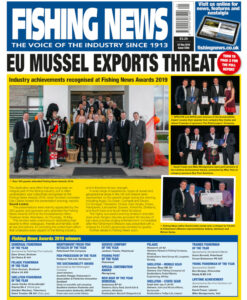 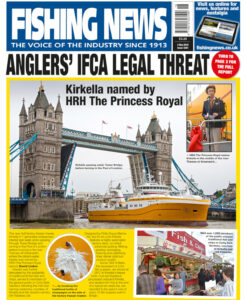 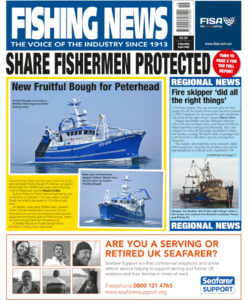 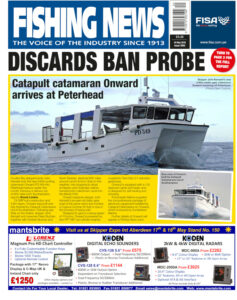 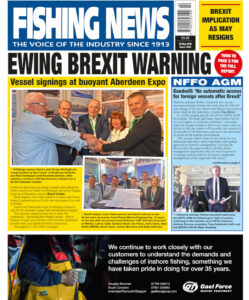 |
In a year in which industry concerns about discards and Brexit frequently resurfaced, political discussions on these ever-present topics continued, with industry leaders taking every opportunity to reinforce the fact that realistic UK quota shares were the answer to discards.
Although Brexit continued to generate more questions than answers, the welcome influx of new boats, the majority of which were in the pipeline pre-referendum, continued.
When the new Peterhead twin-rig trawler Fruitful Bough returned to Whitby after completing fishing trials off Hartlepool, the tranquil mirror-like sea conditions were a complete contrast to those experienced just a few weeks earlier for Carvela.
The run-up to the Fishing News Awards presentation evening in Aberdeen is always an extremely busy period, with the team working hard behind the scenes to ensure that all goes smoothly on the night. This year was no exception, given the additional task of trying to give the venue more of a fishing identity by decorating the reception area and stage with appropriate hardware, including netting, creels, fish baskets (new and old), coils of potting rope and balls of twine. Sincere thanks to everyone who gave invaluable assistance towards that goal.
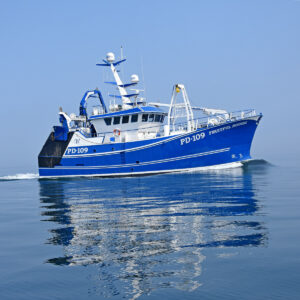
The new Peterhead twin-rig trawler Fruitful Bough returning to Whitby in tranquil conditions.
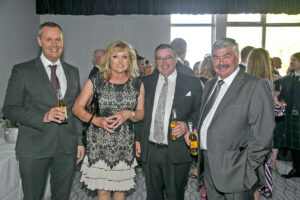
Guests relax during the hastily rearranged drinks reception at the Fishing News Awards 2019…
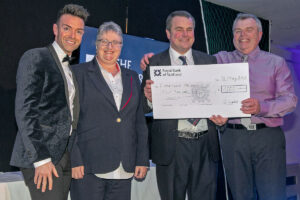
… which concluded with a cheque for £4,000 being presented to the Fishermen’s Mission, thanks to the generosity of well over 300 guests.
By 4pm, when host Des Clarke joined the team for a first-ever walk-through of the stage management for the evening, everything appeared to be well on course for a relaxed evening. Unfortunately, the old adage that a successful haul is never complete until the fish are ashore was seldom more apt.
Within less than a minute of starting the walk-through, the hall was plunged into total darkness, and mobile phone torches were quickly brought into use. Initial thoughts that the audio team had inadvertently overloaded a circuit were quickly dispersed when the hotel management confirmed that all electrical supplies in the immediate vicinity of Aberdeen were out. It transpired that a transformer failure in a substation was to blame.
With no back-up genset, everyone in the hotel – including a number of guests relaxing in their rooms before the awards evening, less than three hours away – was powerless, in every sense of the word.
Fortunately, calmness prevailed (externally, at least), and just as the main flow of guests started to arrive shortly before 7pm for the drinks reception, generously hosted by Lockers Trawlers – which had quickly been moved to an outside room to secure the benefit of daylight – power was restored.
June
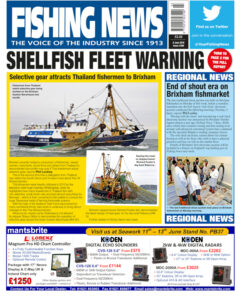 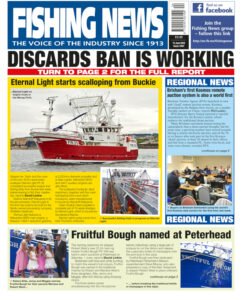 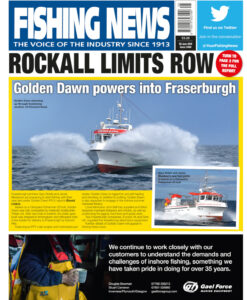 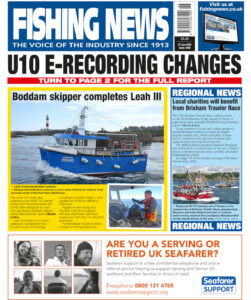 |
Brixham Trawler Agents kick-started June with the first Kosmos ‘web clock’ electronic auction, following a seamless transition from the port’s former traditional shout auction. Coming just six months after Brixham set a new port record annual catch value of £35m, moving to an electronic auction represented another momentous achievement for the South Devon port.
Skipper Robert West’s new twin-rig trawler Fruitful Bough was named, by his three daughters Ellie, Jenny and Maggie in unison, in Peterhead on 1 June.
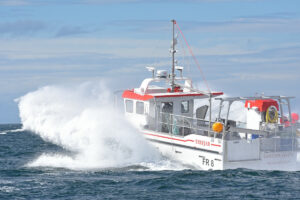
Golden Dawn heading into a northerly breeze off Fraserburgh.
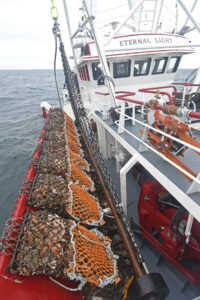
Hauling the starboard dredges for the first time on the new Fraserburgh scalloper Eternal Light, during fishing trials off Buckie.
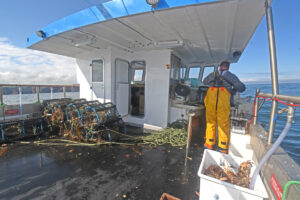
Skipper David Buchan hauling creels on his self-built catamaran Leah III south of Boddam.
Plans to return home the following day were quickly changed on hearing that the new scalloper Eternal Light, built at Buckie by Macduff Shipyards for Whitelink Seafoods Ltd of Fraserburgh, was scheduled to run trials in the middle of what proved to be a particularly productive week, in terms of both feature and news copy.
Following a late night on Peterhead fishmarket, going to Macduff a few hours later netted a range of stories. These included the new Good Hope on the slip after being rolled out of the fabrication hall, the first modules of the new Newlyn trawler Crystal Sea ready to be assembled, traditional caulking skills, and the summer refit season in full swing, including the newly painted Dartmouth vivier-crabber Edward Henry.
Heading back east brought the opportunity to spend time in Whitelink Seafoods’ processing factory in Fraserburgh, to get background information and photographs of the family-owned business for use in the pending Eternal Light new boat feature.
An added bonus later in the afternoon was the opportunity to photograph the new Fraserburgh fast potter Golden Dawn steaming up through a northerly breeze, as well as two local twin-rig trawlers, which subsequently appeared in the Boat of the Week slot.
Fishing trials of the new scalloper Eternal Light went ahead as planned on the Wednesday from Buckie.
The sequence of fortuitous timing continued the following day, when a chance shot to see David Buchan’s new potting catamaran Leah III in action from Boddam materialised out of the blue, at the same time as covering John Kensett’s new Catapult catamaran Onward.
Generating feature copy for four new boats in three days, as well as spending equally productive time at nearby harbours, fully justified the decision to stay in Peterhead following Fruitful Bough’s naming ceremony.
The main news story in June focused on Scotland claiming sovereignty over Rockall waters, after the Scottish government said it would take enforcement action against Irish vessels fishing inside the 12-mile limit – a decision that prompted Jim ’n Alec to leave the Harbour Bar for a trip to the Rock.
July
 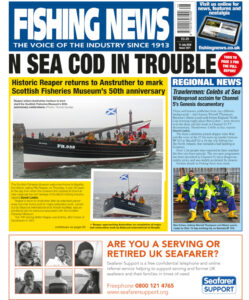 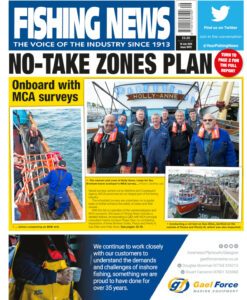 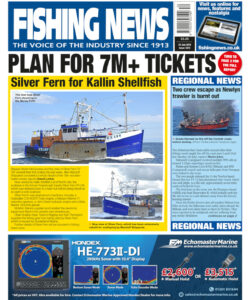 |
July saw the wheel of fortune turn almost full circle, when little if anything slotted into place.
Plans to drive 300 miles to Lochinver to see the new 19m vivier-crabber Amberlisa UL 30, built by Arklow Marine Services for MacMar Fishing Ltd and skippers Jason Coyle and Seamus Rogers, on a Sunday, and continue north to catch the rebuilt scalloper Silver Fern CY 197 landing her first catch at Scrabster the following day, before crossing the Pentland Firth to Stromness for the new Orkney vivier-crabber Carvela K 751, were unfortunately not possible due to a non-negotiable management meeting.
Although Silver Fern and Carvela were subsequently covered, a second opportunity did not come along for Amberlisa. Sorry, lads.
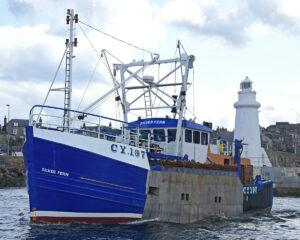
Silver Fern leaving Macduff harbour for a Fishing News photo shoot.
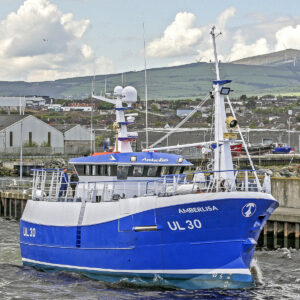
A second opportunity to cover the Arklow-built vivier-crabber Amberlisa unfortunately didn’t materialise.
Flexibility, and the ability to make the most of opportunities to generate feature copy, are vital when trying to see new boats, as the suitable time window is usually tight and difficult to replicate at a later date. Missed chances also have a direct impact on scheduled features, for which alternatives can be difficult to find at short notice.
This proved to be the case towards the end of the month, when the flow of feature copy was particularly nip and tuck over a few issues, requiring new boat material sourced towards the end of a week to be turned around over the weekend in order to meet the weekly production schedule.
ICES advice that the North Sea cod TAC should be cut by almost two-thirds, together with double-figure percentage reductions for the other main species – haddock, whiting and coley – caught in the North Sea mixed fishery in 2020, sent shockwaves through the catching and processing sectors alike.
A WhatsApp message from skipper Martin MacInnes, flagging up that Silver Fern would be at Macduff 36 hours later, resulted in the camera, laptop and personal belongings being quickly thrown into the back of the car, before driving to Peterhead. On arrival, an immediately productive few hours generated a number of news stories and market photographs.
The following morning, as promised, skipper Martin MacInnes took Silver Fern out from Macduff for photographs as soon as there was enough water on the stick. Having watched Silver Fern be virtually stripped back to a bare hull and rebuilt over the preceding 18 months, it was particularly pleasing to see the end result.
Unfortunately, the month ended with a severe bout of food poisoning, enforcing a late call-off of an invitation from Whalsay skipper George Anderson to attend the naming ceremony of the new midwater trawler Adenia at Bilbao, Spain.
August
 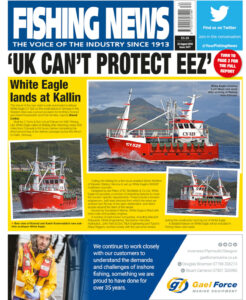 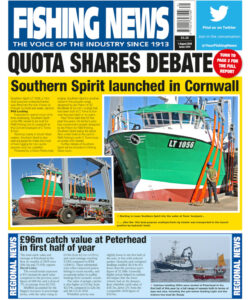 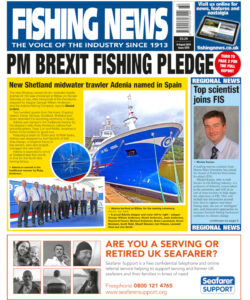 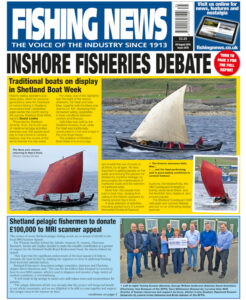 |
After being forced to miss the fishing trials of the new twin-rig trawler Good Hope FR 891 at Macduff, the opportunity to catch skipper Willie Farquhar and crew at Fraserburgh on a Monday morning, a few hours before they left harbour for their first trip, was grasped with both hands.
The evolution of new ideas and the ever-increasing quality of workmanship in new vessels provide a constant reminder of the high level of commitment and expertise of everyone associated with any new build. This should never be overlooked or taken for granted, and everyone who contributes in any way can be justifiably proud of their efforts. Good Hope was no exception.
After spending further time on Peterhead fishmarket the following morning, it was decision time.
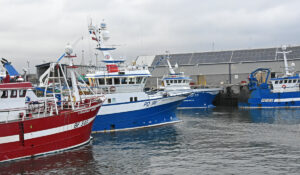
A busy late Sunday night scene at Peterhead fishmarket, 12 hours before…
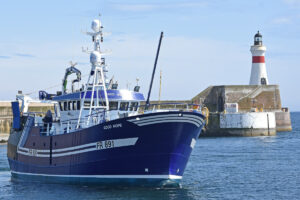
… going to Fraserburgh to see Good Hope preparing for her maiden trip.
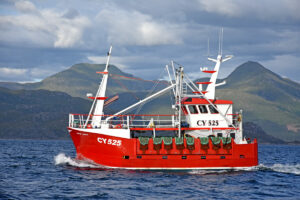
The new Western Isles scalloper White Eagle crossing the mouth of Loch Nevis.
The choice lay between going to Burghead for a night to fulfil a longstanding invitation to report on a thriving port where the inshore squid fishery is gathering pace, before continuing west to Mallaig, where the new Western Isles scalloper White Eagle, built by C Toms & Son at Polruan, was possibly expected to arrive, on passage from Plymouth to Kallin, or returning to northeast England.
With brothers Konrad and Kamil Kosieradzki experiencing mobile signal difficulties on rounding Land’s End, the decision was made to drive home to catch up with news stories ahead of press day, rather than ending up at Mallaig only to find that White Eagle was making straight to Kallin.
Thirty-six hours later, the option chosen turned out to be the wrong one, on receiving a message that White Eagle would arrive at Mallaig in the middle of the following afternoon. While the road alongside Loch Lomond and through Glen Coe was clogged by countless tourists and therefore extremely slow, White Eagle got the tide through the Sounds of Jura and Mull, and therefore arrived at Mallaig first.
Not having had time to put any arrangements in place to photograph White Eagle at sea, possible options were thin on the ground. But as is frequently the case, help was immediately to hand when pulling onto the pier, when a local skipper immediately said that he would take me out. Less than 30 minutes later, White Eagle was steaming across the dramatic background of Loch Nevis.
Boats almost always look better photographed underway at sea, rather than tied alongside a quay with a possibly cluttered background, and therefore provide better value for Fishing News readers. For that reason, and because there is only a single opportunity to get a new boat feature as good as possible, going that little bit further to achieve this is always well worthwhile.
A similar situation arose with the next new boat to be built at Polruan, Southern Spirit LT 1056, when Phil Lockley completed a round trip of over 200 miles from Falmouth to Plymouth earlier this month to catch the scalloper heading in to land at first light. With the ever-willing assistance of designer Rob Terry, the resulting photographs were inserted into the Southern Spirit feature within 60 minutes of Phil returning home at midday, just four hours before that issue of Fishing News went to print.
Concerns that UK waters could not be protected effectively after Brexit as the government admitted to a lack of enforcement capacity, PM Boris Johnson guaranteeing no Brexit fisheries and trade link, and the ever-increasing threat that wind farms pose to the catching sector were among the main news stories of the month.
September
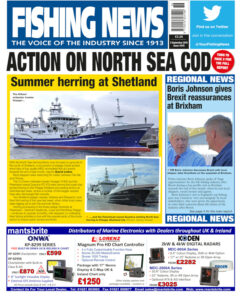  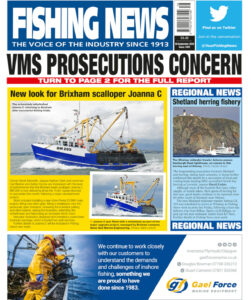 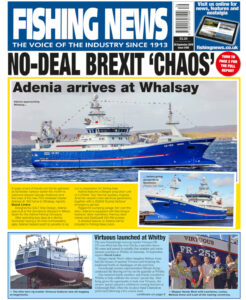 |
International discussion to develop measures to reduce fishing effort on North Sea cod, following ICES advice for a 62% TAC cut, and the reassurances given by Boris Johnson to fishermen at Brixham during a low-profile visit to England’s main landing port, provided the main news stories at the start of the month.
The following week saw the prime minister eating smoked haddock on the deck of skipper James Buchan’s trawler Opportunus IV PD 96 during a similar under-the-radar visit to Peterhead, as MPs continued to debate the much-delayed withdrawal bill.
After several attempts to plan a trip to see North Shields skipper/owner Colin Graham’s under-10m prawn trawler Blueye following a major refit at Bridlington, it was eventually mission accomplished at Eyemouth.
With future feature copy running down again, travel options were quickly evaluated, with the intention of going to Orkney for the new vivier-crabber Carvela, which would keep the pot boiling for the next issue.
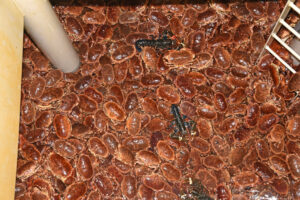
Emptying seawater from Carvela’s vivier hold, prior to landing brown crab at Stromness.
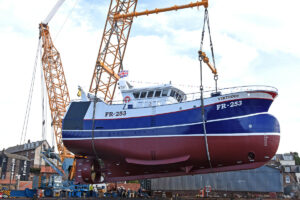
The new-look Fraserburgh twin-rig trawler Virtuous is launched at Whitby.
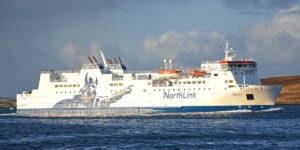
The Northlink ferry Hrossey was a regular mode of transport in late September and early October.
Twelve hours after arriving at Orkney, the flush deck hatch was lifted off the vivier hold shortly after 5am, as the water level rapidly dropped on a six-day trip of brown crab, before crewmen descended the ladder to start putting crab into bongos for landing to a waiting vivier lorry. Less than two hours later, the loaded lorry was pulling off, as the crew started to take on frozen bait, ready for the start of another trip later in the day.
Fortunately, travel logistics that included plane, bus, train and car worked smoothly again on the return journey home, enabling the Carvela feature to be completed in time to meet the weekly production schedule.
The new Fraserburgh twin-rig trawler Virtuous was lifted into the water at Whitby in the middle of the month, when the sun shone brightly for the naming ceremony, which was attended by four generations of skipper Sandy West’s family.
Two days later, Aberdeen was the waypoint to board the NorthLink ferry for the overnight crossing to Lerwick where, the following morning, Hrossey berthed just 200m away from the new midwater trawler Adenia LK 193, which was the main reason for going to Shetland.
Skipper George Anderson and crew were busy rigging out the 70m Adenia, which had arrived at Whalsay 48 hours earlier from Bilbao, Spain, via a quick pit-stop at Killybegs to take on two new midwater trawls and braillers from KT Nets.
Having obtained most of the information and photographs required, with the help of an ever-willing crew, a few brief phone calls were then made to secure health and safety access to the new whitefish markets that were rapidly nearing an advanced stage of completion within five miles of each other at Lerwick and Scalloway.
Other September headline news included calls to retain the quota system, concerns about VMS-based prosecutions, and warnings of no-deal Brexit mayhem and possible conflict and port blockades across Europe.
October
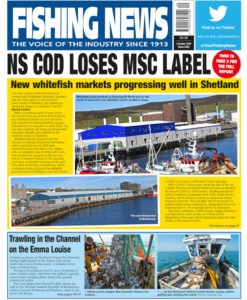 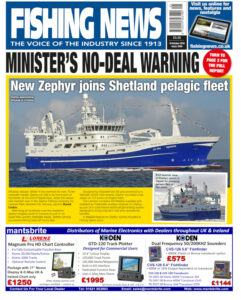 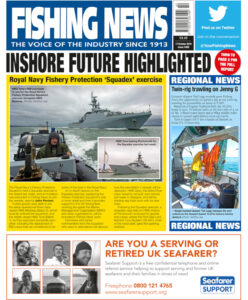 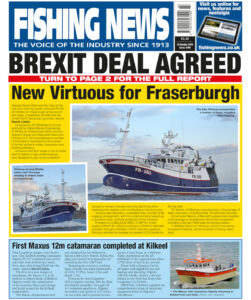 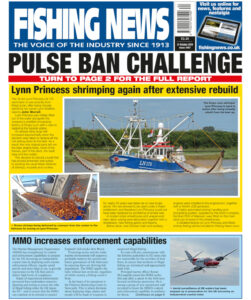 |
Shetland again provided the working location at the start of the month, although the passage north started badly by watching a 10-man Newcastle lose heavily at Leicester in the Premiership, before the haddock and chips provided a modicum of comfort.
Within an hour of Hrossey berthing at Lerwick, the Whalsay ferry Linga left the pier at Laxo for Symbister, where the new midwater trawler Zephyr LK 394 had arrived 36 hours earlier.

The Northlink ferry Hrossey was a regular mode of transport in late September and early October.

The new Whalsay midwater trawler Zephyr berthed at Symbister in early morning sunlight.
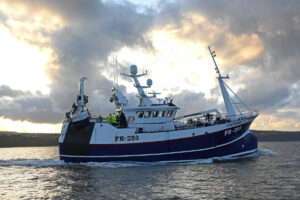
Virtuous leaving Whitby for Fraserburgh in rapidly fading light.
After meeting skipper Allister Irvine and taking some photos in the accommodation areas, an hour later the second ferry on the continuous Whalsay service, Hendra, provided the 45-minute return crossing to the mainland. After the 10-mile drive back south to Lerwick, arrangements were quickly confirmed to intercept Zephyr heading down there in mid-afternoon, thanks as always to the ever-helpful Lerwick Port Authority team.
A couple of hours later, the pilot boat Knab headed out through the north entrance of Lerwick harbour as Zephyr came south on a reciprocal course, before the boats converged in a brief but timely sunny spell between some heavy rain squalls, giving ideal conditions for photographs.
As ever when in Lerwick, the Shetland Fishermen’s Association office was a frequent port of call, in order to write, gain Wi-Fi access and email news stories and photographs. Sincere thanks, guys.
The next new boat, Virtuous, was considerably closer to home at Whitby. Having been unable to go on fishing trials due to being in Shetland, it was fortunately possible to catch the very interesting new design of twin-rig prawn trawler a few hours before skipper Sandy West left the harbour for Fraserburgh. Being a tidal harbour, sailing times are dependent on the tide and bridge opening times, which towards the winter solstice can give problems due to the short hours of daylight. A 5.20pm sunset meant it was essential that Virtuous got the first bridge at 5pm, which was achieved by virtue of everyone working together.
The MSC’s decision to suspend the ‘blue tick’ label for North Sea cod, awarded in the summer of 2017, after scientific advice that the stock is below safe biological levels, was the dominant news story, followed by the announcement of a Dutch legal challenge to the EU pulse ban, and expectation that a Brexit deal was on the cards – although this quickly proved not to be the case.
November
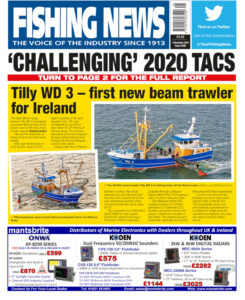 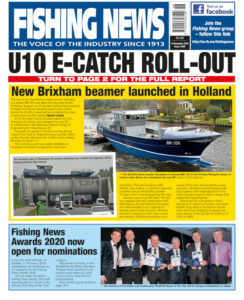  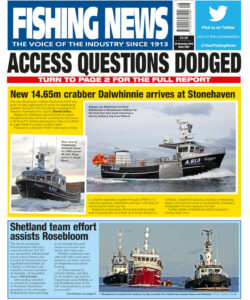 |
News of proposed cuts in 23 stocks of crucial importance to UK fishermen provided bleak headlines at the beginning of the month, as warnings of further delays on implementing Brexit continued. The ingredients for another ‘perfect storm’ were coming together yet again.
In an industry where inconsistency is all too regularly the only consistent factor – particularly in terms of fisheries management and fishing opportunities – the high level of tenacity and commitment fishermen show, while getting on with their jobs with a steely determination, is a model that politicians would do well to follow.
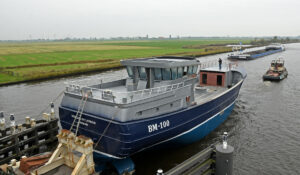
The new Brixham beamer Margaret of Ladram in the Prinses Margriet canal, heading for completion by Luyt BV at Den Oever.
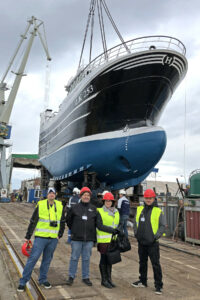
A proud day for Skerries, Shetland as Ocean Challenge is lifted into the water at Gdynia.
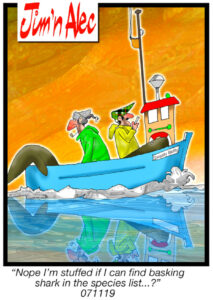
Jim ’n Alec struggle to find the right box to tick in the MMO’s new e-catch recording system.
While Brexit has rumbled on for over three years, fishermen and processors alike have buckled down to the task in hand to ensure normal service, despite endless uncertainties. These have included foreign vessels increasing fishing effort on UK grounds, highlighting the extent to which other EU countries rely on fish caught in British waters, and the efforts they are making to maximise their share of this natural resource – despite the fact that it has been enhanced by the sustainable measures implemented by UK fishermen over the past 15 years, and counting.
Further evidence of the confidence that UK fishermen have in the future of their industry, based on healthy stock levels, was provided by the launch of three new whitefish trawlers in quick succession. The 35.25m Georgina of Ladram for Brixham – the first new beam trawler of its class for 20 years – and two stern trawlers for northeast Scotland and Shetland, gave a timely reminder of the industry’s continuing commitment to protecting remote communities, spanning the length of the UK, that are heavily reliant on fishing.
The realisation that two scheduled features were not going to be received as expected created a potential shortfall in page content – a situation that was not helped by a PC failure. Fortunately, as several doors slammed shut, a small window of opportunity arose with the arrival at Stonehaven of the new crabber Dalwhinnie, following a stormy delivery passage from Kilkeel. Having contacted skipper Ian Mathieson just 24 hours earlier, he and his crew, together with an equally important small boat, were all ready to throw off the ropes as soon as I drove onto the pier, with an hour of daylight remaining, and the tide coming. Some things are meant to happen.
The MMO’s full phase-in of e-catch recording for under-10s in England and Wales via a mobile phone app provided the month’s main news story, as well as generating a substantial amount of heated discussion as to its merits and practicalities.
December
 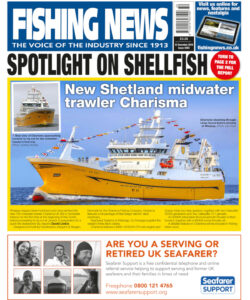 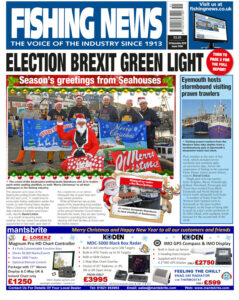 |
The penultimate issue of Fishing News signalled the starboard light for Brexit to finally happen, following the general election result. With a substantial majority, the government now has a clear mandate to steer the Brexit withdrawal bill through parliament before the deadline of 31 January, and finally free the industry from the shackles of the dreaded CFP, after 40 years of top-down fisheries management, much to the detriment of the UK fleet.
Opportunity also brings responsibility to deliver an end result that will stand the industry in good stead for many years to come, and enable future generations of fishermen to harvest the rewards from the highly successful measures that the present forward-thinking generation has implemented, despite the hardship this has entailed along the way.
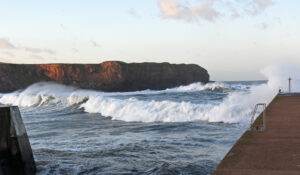
A northerly gale down the east coast…
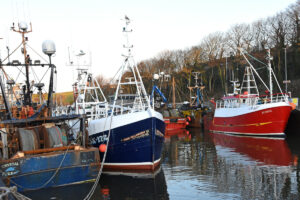
… kept local and visiting prawn trawlers in Eyemouth harbour, and brought the opportunity for a New Year photograph.
By delivering a result of profound significance for the UK fishing industry, the general election also ensured an extremely busy Friday morning before Fishing News went to print. The ability to respond to breaking news is a key requisite for any newspaper, regardless of the challenges it brings.
To this end, Fishing News is in an extremely good position, thanks to the skills and willingness of designer Rob Terry and legendary newshound Tim Oliver, who stand ready to go that extra mile whenever the need arises. The same is true of our small team of regular contributors, who each bring their own strengths and experiences to deliver a wide range of features and news stories throughout the year, all of which are painstakingly sub-edited and proofed by Gaby Bartai. Thanks, guys.
Father Christmas visited Seahouses harbour three weeks ahead of his regular schedule in order to meet pre-Christmas print deadlines. During a period of limited travel opportunities, a breakfast text to Seahouses potting skipper Jonathan Dawson brought the opportunity to get a ‘Merry Christmas’ photograph later in the day, when Santa and his willing helpers embraced the festive spirit as Standsure and JJ returned to harbour to land their daily catches of brown crab and lobsters, shortly before darkness descended.
A few days later, an accurately forecasted northerly gale brought an equally welcome opportunity for a New Year photograph, when crewmen from the Stornoway prawn trawlers Kaylana and Ambitious stepped up to the mark at Eyemouth. Thanks, lads, for helping out.








